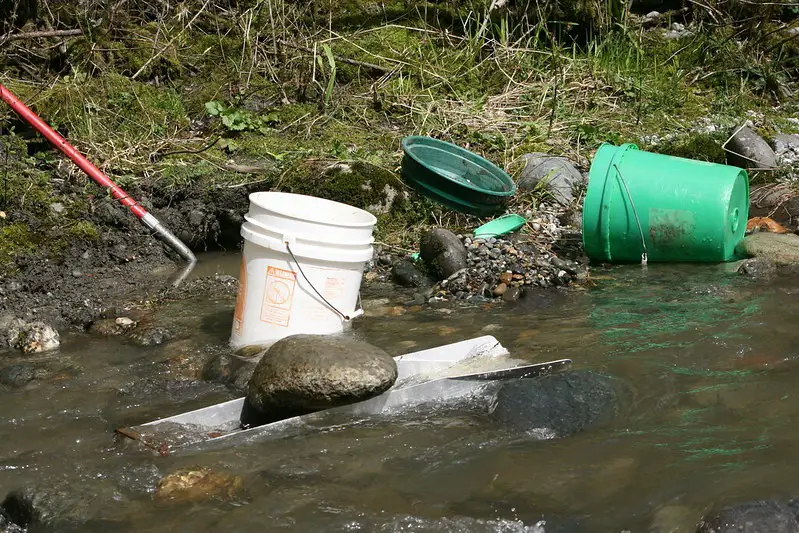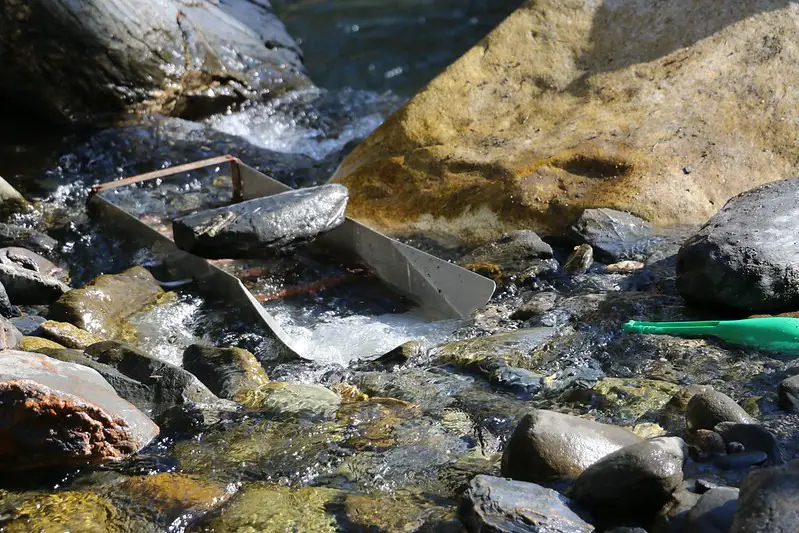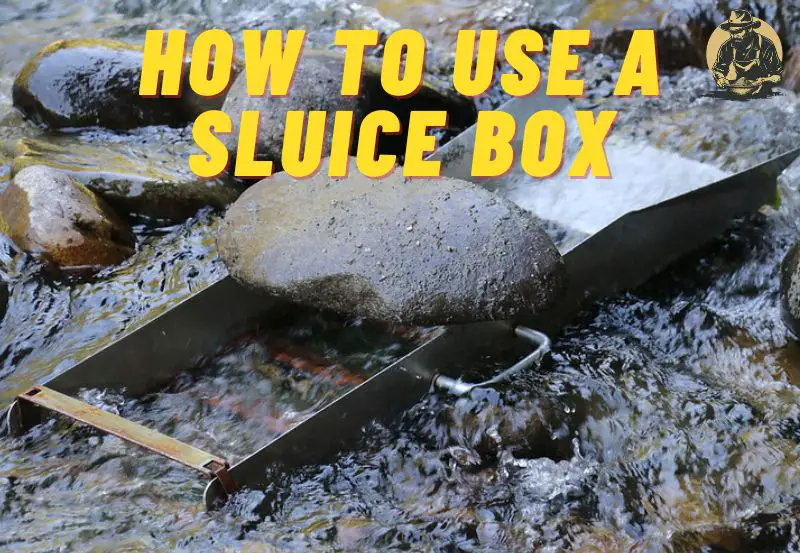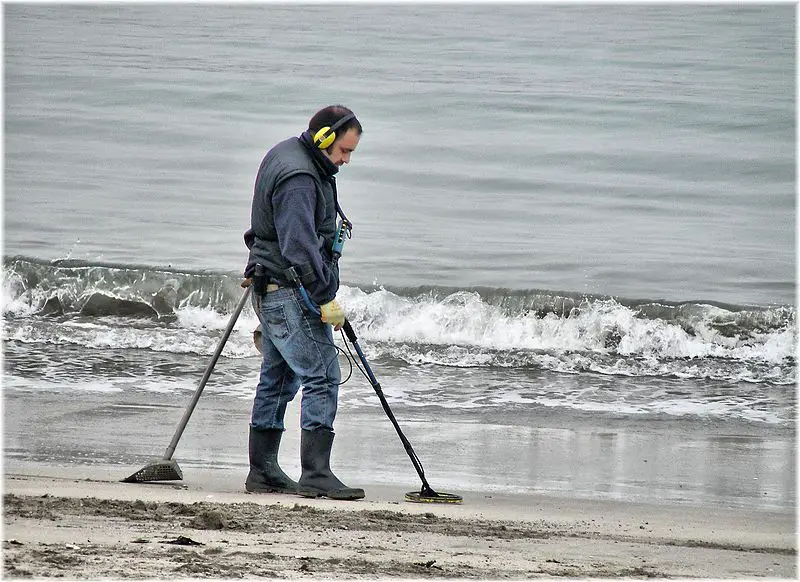In the article “How to Use a Sluice Box: Mastering Gold Recovery Techniques,” you’ll learn about the detailed process involved in setting up and operating a sluice box for gold prospecting. It also covers various tools used in the process, such as Rock Pick Hammers, and the optimal setup and angle for the sluice box to maximize gold recovery. The article addresses common challenges faced during prospecting, like panning out concentrate and separating black sand. For those interested in further exploring sluice box techniques, the article hints at future content to answer additional questions and delve deeper into the subject.

How to Use a Sluice Box: Setting up a Sluice Box
Choosing the right location
When setting up a sluice box for gold prospecting, it’s important to choose the right location. Look for areas where there may be potential gold deposits, such as rivers, streams, or creeks. Consider factors like accessibility, water flow, and the presence of gravel or rocks. It’s also crucial to ensure that you have permission to prospect in the chosen area and to follow any local regulations or restrictions.
Preparing the sluice box
Before using a sluice box, it’s essential to prepare it properly. Clean the sluice box thoroughly to remove any debris or sediment that may interfere with the flow of water and the capture of gold. Ensure that all the components of the sluice box, such as riffles and matting, are securely in place and free from any defects or damage. Familiarize yourself with the setup and functionality of the sluice box to optimize its performance during gold recovery.
Securing the sluice box
Once the sluice box is prepared, it’s crucial to secure it in place. Choose a level and stable spot near the body of water you are prospecting. Use rocks or other materials to create a dam or secure the sluice box to prevent it from shifting or being swept away by the current. Make sure that the sluice box is positioned at the proper angle to allow for the efficient flow of water and gravity-based separation of gold particles.
How to Use a Sluice Box: Running a Sluice Box
Adding gravel to the sluice box
To begin running a sluice box, add gravel to the top of the sluice box. Ensure that the gravel is adequately wet to allow for easier movement and separation of gold particles. It may be necessary to add water to the gravel to achieve the desired moisture level. The amount of gravel added will depend on the size of the sluice box and the volume of gravel that can be effectively processed in one run.
Adjusting the angle of the sluice box
The angle of the sluice box is crucial for optimal gold recovery. Adjust the angle of the sluice box to facilitate the movement of gravel and the separation of gold particles. A general rule of thumb is to set the sluice box at an inch per foot of box drop. However, the angle may need to be adjusted depending on the type of gold present in the area. Fine gold may require a flatter angle, while larger gold particles may require a steeper angle.
Monitoring the flow of water
As you run the sluice box, it’s essential to monitor the flow of water. Ensure that the water is flowing smoothly and evenly through the sluice box, without any interruptions or blockages. Observe the movement of gravel and pay attention to any signs of gold being captured in the sluice box. Adjust the flow of water or the angle of the sluice box if necessary to optimize gold recovery.

Optimizing Gold Recovery
Understanding riffles and matting
Riffles and matting are integral components of a sluice box that help capture and retain gold particles. Riffles create barriers and turbulence in the flow of water, allowing heavier materials like gold to settle and be trapped. Matting provides a surface for gold particles to cling to, preventing them from being washed away. Understanding the structure and function of riffles and matting is essential for optimizing gold recovery in a sluice box.
Cleaning and maintaining the sluice box
Regular cleaning and maintenance of the sluice box are crucial for optimal gold recovery. Remove any accumulated sediment, debris, or black sand from the riffles and matting to prevent clogs and maximize the capture of gold particles. Inspect the sluice box for any damages or wear and repair or replace any components as needed. Proper cleaning and maintenance of the sluice box will ensure its longevity and efficiency in gold recovery.
Using classifiers to increase efficiency
Classifiers are sieves or screens that help separate different sizes of gravel and rocks. Using classifiers before adding the gravel to the sluice box can help increase the efficiency of gold recovery. By removing larger rocks and allowing only smaller-sized material to enter the sluice box, the chances of capturing fine gold particles are enhanced. Classifiers are available in various mesh sizes and can be easily incorporated into the gold prospecting process.
Finding Gold with a Sluice Box
Identifying potential gold-bearing areas
To find gold with a sluice box, it’s important to identify potential gold-bearing areas. Research the geological history of the region and look for signs of past or present gold deposits. Pay attention to indicators such as quartz veins, iron staining, or mineralized rock formations. Understanding the characteristics and geology of gold-bearing areas can help narrow down the search and increase the chances of finding gold with a sluice box.
Techniques for locating gold
Locating gold with a sluice box requires using specific techniques. Start by sampling different areas with test pans or metal detectors to identify promising spots. Once a potential area is identified, dig and collect samples from different locations within that area. Process the samples through the sluice box and observe any signs of gold being captured. Adjust the location or technique based on the results obtained to increase the chances of finding significant gold deposits.
Recognizing signs of gold in the sluice box
While running a sluice box, it’s important to recognize signs of gold being captured. Observe the behavior of the gravel and pay attention to any changes in color or texture. Look for black sand or heavy minerals, as they can indicate the presence of gold. Often, gold will settle behind riffles or cling to matting, so carefully inspect these areas for small, shiny particles. Regularly clean out the sluice box and pan or analyze the concentrate to assess the amount and quality of gold being recovered.

Utilizing Additional Tools and Equipment
Using a metal detector
Using a metal detector in conjunction with a sluice box can be an effective method for finding gold. Metal detectors can help locate gold nuggets or individual gold particles that may be missed during the initial prospecting process. When using a metal detector, sweep the area systematically, paying attention to any signals or indications of metal objects. Once a target is detected, use a rock pick hammer or other tools to extract the potential gold.
Using specific hammers and rock picks
Specific hammers and rock picks can be useful for gold prospecting with a sluice box. Estwing 14 oz. Rock Pick Hammer and 22 oz. Rock Pick Hammer are popular choices for breaking up rocks and extracting potential gold. These tools are durable and designed to withstand the demanding conditions of gold prospecting. When using hammers and rock picks, exercise caution and wear appropriate protective gear to ensure safety.
Applying insect repellent
When working in outdoor environments while running a sluice box, it’s advisable to apply insect repellent. Mosquitoes, flies, and other insects can be bothersome and distract from the gold prospecting process. Apply insect repellent according to the manufacturer’s instructions to protect against bites and discomfort. By keeping insects at bay, you can focus more on the task at hand and maximize your chances of finding gold.
Running Dry Gravel in the Sluice Box
Preparing dry gravel for processing
Running dry gravel in a sluice box requires specific preparation. Dry gravel should be broken down into smaller, manageable pieces before being added to the sluice box. Use a rock pick hammer or appropriate tools to break up large rocks and ensure uniformity of size. It may also be necessary to classify or screen the dry gravel to remove any oversized or undersized material that could hinder gold recovery.
Importance of properly dried gravel
Properly dried gravel is essential for running it through a sluice box. Ensure that the dry gravel is adequately dried and free from moisture to prevent clumping or clogging in the sluice box. Moisture in the gravel can impede the flow of water and hinder the separation of gold particles. Allow the gravel to air dry or use appropriate methods to remove any excess moisture before processing it in the sluice box.
Efficiently feeding dry gravel into the sluice box
When feeding dry gravel into a sluice box, it’s important to do so efficiently to optimize gold recovery. Feed the gravel into the sluice box at a steady pace, allowing the water to move the material along the sluice box without causing any blockages. Avoid adding too much dry gravel at once, as it can overwhelm the sluice box and compromise its efficiency. By feeding the dry gravel in a controlled and consistent manner, you can maximize the chances of capturing gold.
Sluice Box Cleanup and Gold Separation
Collecting and panning out the concentrate
After running the sluice box, it’s time to collect the concentrate and separate the gold. Carefully remove the sluice box from the water and place it on stable ground. Use a gold pan or similar device to collect the concentrates from the bottom of the sluice box. Gently swirl the pan in a circular motion to allow the gold particles to settle at the bottom while the lighter material is washed away. Repeat this process until only the gold remains in the pan.
Separating black sand from gold
Black sand, which often accompanies gold deposits, needs to be separated from gold during the cleanup process. Black sand is composed of heavy minerals that are similar in color and density to gold, making it challenging to distinguish between the two. One effective method for separating black sand from gold is by utilizing a magnet. Pass a magnet over the concentrate to attract and remove the black sand particles, leaving behind the gold.
Minimizing gold loss during cleanup
During the cleanup process, it’s crucial to minimize gold loss and retain as much of the precious metal as possible. Handle the concentrate and gold with care to avoid any accidental spills or losses. Use appropriate techniques and equipment, such as gold pans or sluice mats, to ensure efficient separation and capture of gold. Regularly inspect the cleanup process and make adjustments as needed to optimize gold recovery and minimize any potential losses.
Conclusion
Setting up and operating a sluice box for gold prospecting is both enjoyable and rewarding. The process involves selecting a prime location, correctly preparing and positioning the sluice box, and ensuring optimal water flow for effective gold recovery. Mastery of techniques such as adjusting angles, using riffles and matting, and employing classifiers is key. Additional tools like metal detectors and hammers, as well as using insect repellent, can enhance your prospecting experience. Key skills include running dry gravel, cleaning the sluice box, and separating gold from black sand. There’s potential to learn more advanced methods and address common questions in future discussions. With proper knowledge and persistence, your gold prospecting adventures can be both successful and exciting.
Disclosure: As an Amazon Associate, I earn from qualifying purchases.




